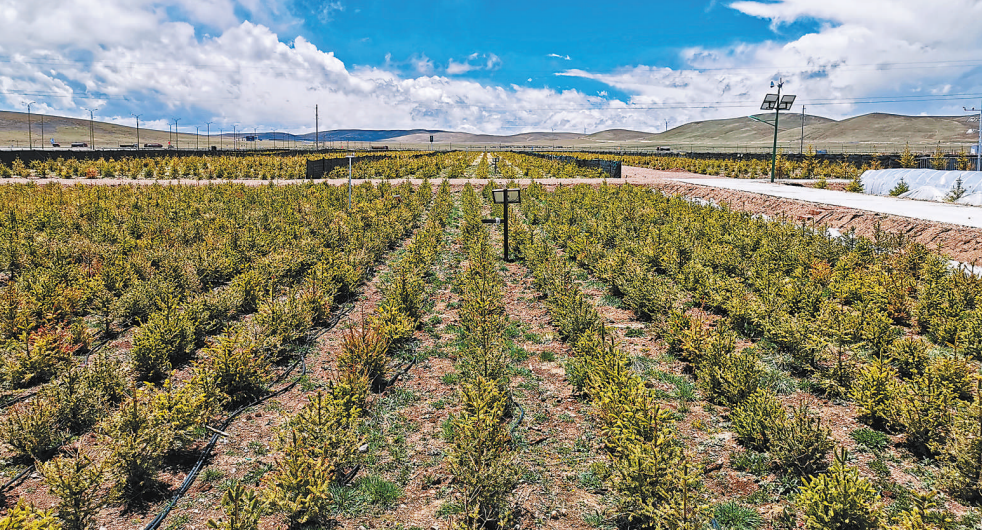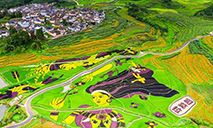Nagqu in Tibet tackles difficulties in high-altitude afforestation

Photo taken in June 2019 shows dragon spruces planted in a nursery garden under a key technology development program of urban afforestation in Nagqu. (Photo by Hao Wei)
It is an easy task to grow a tree. But it is not in Nagqu, a city with an average altitude of 4,500 meters in China's Tibet autonomous region.
"The permafrost is thick here and there are only two prime growing months for the trees each year," said Hao Wei, general manager of an eco-technology firm based in the city under the Elion Resources Group.
According to him, the long snow season and soil freezing period would cause freezing injury for saplings, which makes it hard for them to root and always leads to low lignification.
However, afforestation must be advanced there despite difficulties, as the Qinghai-Tibet Plateau, where the city locates, is the "water tower of Asia" that works as an important ecological safety barrier.
In 1998, the city's first test base of tree planting was built by forestry technicians. The base covered only two mu, or 0.13 hectares, and was planted with Salix cupularis, Myricaria prostrata and sea-buckthorn. However, the results were not satisfying.
Nine years later, forestry technicians had another try and introduced dragon spruces and some other Salix cupularis, and finally 14 of them survived, which are the oldest trees in Nagqu today.

Photo shows protection covers in a nursery garden under a key technology development program of urban afforestation in Nagqu. (Photo by Hao Wei)
In November 2016, the Ministry of Science and Technology kicked off a key research campaign of vulnerable ecology restoration and protection, including a key technology development program of urban afforestation in Nagqu. The program was led by the Elion Resources Group, which has made huge greening efforts in the Kubuqi Desert in north China's Inner Mongolia autonomous region, and joined by multiple research institutions.
Regular afforestation technologies don't work well in Nagqu. Therefore, how to find effective solutions was an arduous task for the Elion Resources Group and the research institutions.
"We used big data for seedling selection and breeding, which allowed us to screen and compare germplasm resources on a large scale," said Hao, adding that eight of the 50 tree species they tested survived.
He introduced that a climate monitoring station was built to collect indicators such as temperature, humidity, wind velocity, soil conditions and plant growth, based on which they have tailored and implemented multiple wind- and cold-resistance measures.
According to Hao, atomization irrigation was adopted to increase air humidity, in case the strong ultraviolet ray impacts the growth of the plants. To address the problems of low soil temperature, the trees have been fenced by high polymer materials, which accumulates water and works as a sunscreen. Besides, these materials also turn solar radiation into heat, so that the roots of the trees are kept warm.
"After five years of hard work, we figured out a practical tree planting mode in high-altitude areas. We planted 400,000 trees and 75 percent of them survived," said Wang Wenbiao, chairman of board of the Elion Resources Group, adding that the people in Nagqu now have "small forests" at their doorsteps.
Such achievements are now widely applied in Nagqu. Last year, the city's science and technology bureau, parks, children's homes, and nursing homes all started small-scale greening work.

Photo shows the Namtso Lake in Nagqu. (People's Daily Online/Han Jiajun)
"I've never seen trees before coming here," said Sherab, 52, from Nagqu's Gachen village. Three years ago, he started working in a demonstration base of high-altitude afforestation in the city, and now, the base is all green. The man said he had never believed that one day trees would grow in his hometown. "My children are lucky that they are living in a city covered by trees," Sherab noted, adding that he will take good care of these plants.
"I can see trees sitting in my room, and birds are making nests on the branches. I feel great every day," said a 72-year-old resident surnamed Sangmet who lives in a nursing home in Kormang township, Nagqu.
Photos
 Dance show saluting traditional culture of the Song Dynasty makes its debut
Dance show saluting traditional culture of the Song Dynasty makes its debut Village in SW China’s Yunnan embraces prosperity through agricultural tourism
Village in SW China’s Yunnan embraces prosperity through agricultural tourism Eighth birthday for pair of giant pandas celebrated in Haikou, Hainan province
Eighth birthday for pair of giant pandas celebrated in Haikou, Hainan province Olympic gold medalists portrayed in Shanxi artist’s polymer clay sculptures
Olympic gold medalists portrayed in Shanxi artist’s polymer clay sculptures
Related Stories
Copyright © 2021 People's Daily Online. All Rights Reserved.






